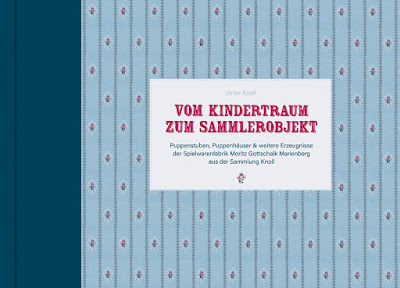In den 60ern und 70ern entstand ein neuer Zimmertyp:
das Jugendzimmer
- hier auch aufs Puppenhaus übertragen.
Dieses Jugendzimmer ist unter dem Dach.
Balken, Wände und Boden sind aus bedruckter Pappe,
dazu Möbel und Zubehör aus Plastik.
Das Mädchen muss reiche Eltern haben,
wer hatte denn zu dieser Zeit ein Fernsehen, Radio,
Plattenspieler und ein Telefon im Zimmer?
Wer hatte überhaupt ein Zimmer für sich allein?
Wer hatte überhaupt ein Zimmer für sich allein?
Puppenstuben haben immer einen Trend repräsentiert
- und welches Mädchen hätte nicht von so einem Zimmer geträumt?
Warum sollte man ihr nicht wenigstens die Miniaturausgabe schenken.
Der Sessel ist von mir ergänzt,
es gehört eigentlich ein Plastik-Drehstuhl in blau dort hin,
ursprünglich hangen am Dachbalken zwei Gitarren
und auf dem Boden
müssten noch zwei Tennisschläger liegen.
Der Teenager ist aus den 80ern,
denke ich,
das Erna-Meyer-Mädchen sieht in ihrer chicen Lederhose
und
ihrer herausfordernden Haltung
aber wie die Bewohnerin dieses kleinen
Paradieses aus.
A new market: furniture designed especially for young people,
here adopted for the dolls house.
This room is under the roof.
Beams and walls are made of cardboard,
with plastic furniture and many accessoires.
The girl has wealthy parents, who else had a TV,
The girl has wealthy parents, who else had a TV,
a radio, a record player and a telephone in her room?
Who had a room of her own anyway?
But dolls houses always represent the trend of a time -
But dolls houses always represent the trend of a time -
and every girl would have dreamed of such a room -
so why not give her the miniature edition at least?
The room is not complete: it is not the original armchair
and a second guitar and the tennis rackets are missing.
The Erna-Meyer-doll is from the 80s, I guess,
she is wearing fashionable leather trousers.

Ich bat einen Freund wegen der Poster um Hilfe,
da ich mir nicht so sicher war,
wen sie darstellen: Jimi Hendrix, klar, stand ja drauf,
Che Guevara, Dieter Thomas Heck,
bei den anderen konnten wir uns nicht einigen, wer soll die Frau sein?
Juliane Werding? "Am Tag, als Connie Kramer starb"?
Der blinde Sänger könnte Ray Charles sein,
aber ich denke zu dieser Zeit eher Stevie Wonder.
Links der Sänger spielt eine Sitar, laut Auskunft meines Freundes,
ist es aber keiner der damals bekannten Sitar-Spieler
(ich wusste gar nicht, dass es Sitar-Spieler gab).
02.08.2017
OKKO BEKKER Sitar & Electronics
Danke, Georgia!
I asked a friend, who is a great music fan,
about the posters on the wall because I was not sure about every one of it:
Jimi Hendrix, Che Guevara,
Dieter Thomas Heck (wellknown german discjockey of this time),
Stevie Wonder (or Ray Charles?) but who is playing the sitar?
1974
also nur ein Jahr später, gab es eine Modelländerung bei Modella.
Das Farbkonzept für das Teenagerzimmer wurde beibehalten,
das Möbeldesign aller Zimmer wurde in ein modulares System umgewandelt.
Just one year later, Modella underwent a model change.
The colour concept for the teenager's room was retained,
and the furniture design for all rooms was converted into a modular system.
The colour concept for the teenager's room was retained,
and the furniture design for all rooms was converted into a modular system.
Modella-Jugendzimmer im VEDES-Katalog
unten links
Zuletzt aktualisiert 1.9.2025
Wenn nicht anders vermerkt, sind alle Fotos aus meiner Sammlung
 diePuppenstubensammlerin
diePuppenstubensammlerin
Dieses Werk ist lizenziert unter einer Creative Commons Namensnennung - Nicht kommerziell - Keine Bearbeitungen 4.0 International Lizenz.
 diePuppenstubensammlerin
diePuppenstubensammlerinDieses Werk ist lizenziert unter einer Creative Commons Namensnennung - Nicht kommerziell - Keine Bearbeitungen 4.0 International Lizenz.







.JPG)







.jpg)



